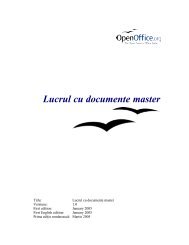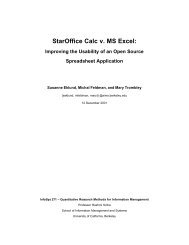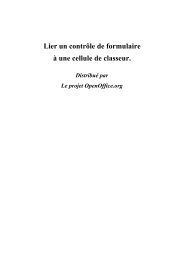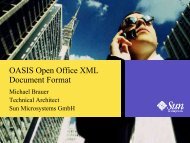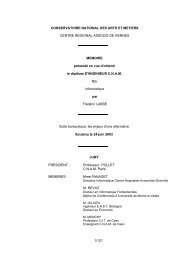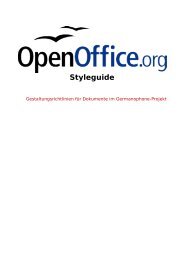The Microsoft Excel File Format - OpenOffice.org
The Microsoft Excel File Format - OpenOffice.org
The Microsoft Excel File Format - OpenOffice.org
You also want an ePaper? Increase the reach of your titles
YUMPU automatically turns print PDFs into web optimized ePapers that Google loves.
2.5 Common Record Substructures<br />
2.5 Common Record Substructures<br />
This chapter contains information about basic substructures which do not belong to specific records, for instance strings,<br />
error codes, constant values, URLs, or line and area formatting.<br />
2.5.1 <strong>Format</strong>ting Runs<br />
<strong>Format</strong>ting runs describe the character formatting of strings. A formatting run contains the index of a character and the<br />
index of a font in the font buffer. <strong>The</strong> font is used to format the indexed character and the following characters, until the<br />
string ends or another formatting run follows.<br />
<strong>Format</strong>ting run, BIFF2-BIFF5:<br />
Offset Size Contents<br />
0 1 First formatted character (zero-based)<br />
1 1 Index to FONT record (➜5.45)<br />
<strong>Format</strong>ting run, BIFF8:<br />
Offset Size Contents<br />
0 2 First formatted character (zero-based)<br />
2 2 Index to FONT record (➜5.45)<br />
2.5.2 Byte Strings (BIFF2-BIFF5)<br />
All <strong>Excel</strong> file formats up to BIFF5 contain simple byte strings. <strong>The</strong> byte string consists of the length of the string<br />
followed by the character array. <strong>The</strong> length is stored either as 8-bit value or as 16-bit value, depending on the current<br />
record. <strong>The</strong> string is not zero-terminated. <strong>The</strong> encoding of the character array is dependent on the current record (for<br />
example taken from the CODEPAGE record, ➜5.17, or from the FONT record, ➜5.45).<br />
Offset Size Contents<br />
0 1 or 2 Length of the string (character count, ln)<br />
1 or 2 ln Character array (8-bit characters)<br />
2.5.3 Unicode Strings (BIFF8)<br />
From BIFF8 on, strings are always stored using UTF-16LE 3 text encoding. <strong>The</strong> character array is a sequence of 16-bit<br />
values 4 . Additionally it is possible to use a compressed format, which omits the high bytes of all characters, if they are<br />
all zero.<br />
<strong>The</strong> following table describes the standard format of the entire string, but in many records the strings differ from this<br />
format. This will be mentioned separately. It is possible (but not required) to store Rich-Text formatting information and<br />
Asian phonetic information inside a Unicode string. This results in four different ways to store a string. <strong>The</strong> character<br />
array is not zero-terminated.<br />
3<br />
For more information see http://en.wikipedia.<strong>org</strong>/wiki/UTF-16.<br />
4<br />
In most cases each value corresponds to a Unicode character. Only the Unicode characters above U+FFFF are encoded with a<br />
“surrogate pair”, that are two 16-bit code values in UTF-16 (see footnote 3).<br />
17





